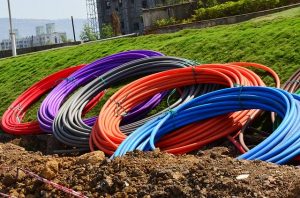
Not all cables are made of copper or aluminum. When used to transmit data, cables are often made of optical fibers. Known as fiber optic cable, it’s used extensively in telecommunications applications. Even if you’re unfamiliar with fiber optic cable, you’ve probably used it to send or receive data. Homes and businesses throughout the world use fiber optic as part of their internet connection. To learn more about fiber optic cable, keep reading.
Overview of Fiber Optic Cable
Also known as optical fiber cable, fiber optic cable is a type of data-transmitting cable that’s made of thin and narrow strands of silica. Silica, of course, is glass. In fiber optic cable, the silica strands are bundled together to provide a fast and efficient means of data transmission. Each strand of silica in a fiber optic cable is roughly the same size in diameter as a strand of human hair.
There are different standards in which fiber optic cable is made and sold, some of the most common being:
- OFC
- OFN
- OFCG
- OFNG
- OFCP
- POFCR
- OFNR
- ADSS
- OSP
- MDU
Why Fiber Optic Cable Instead of Copper or Aluminum Cable
Copper and aluminum cables are common choices for electrical cables. Both copper and aluminum are highly conductive, so they are able to easily transfer electricity across long distances with minimal loss of power. Unfortunately, copper and aluminum — along with other conductive materials — are poor choices for data-transfer cables. If a cable is used to transfer data, a different material must be used, such as fiber optics.
Fiber optic cable is arguably the best choice for transferring data because it minimizes signal loss. While data can travel through copper and aluminum cables, it loses a substantial amount of its signal. In comparison, fiber optic cable maintains a strong signal, even when used over long distances.
Another reason fiber optic cable is used for data-transfer applications is because it’s immune to electromagnetic interference. Electromagnetic interference is all around us. Anything that produces or transfers electricity will release electromagnetic interference. Exposure to this electromagnetic interference can cause a signal loss in cables made of copper or aluminum. This isn’t an issue with fiber optic cable, though, as it’s immune to electromagnetic interference.
In Conclusion
Fiber optic cable is a type of glass-based cable that’s used in data-transfer applications. It’s made of individual strands of glass, which allow data to travel across long distances while maintaining a strong signal.
